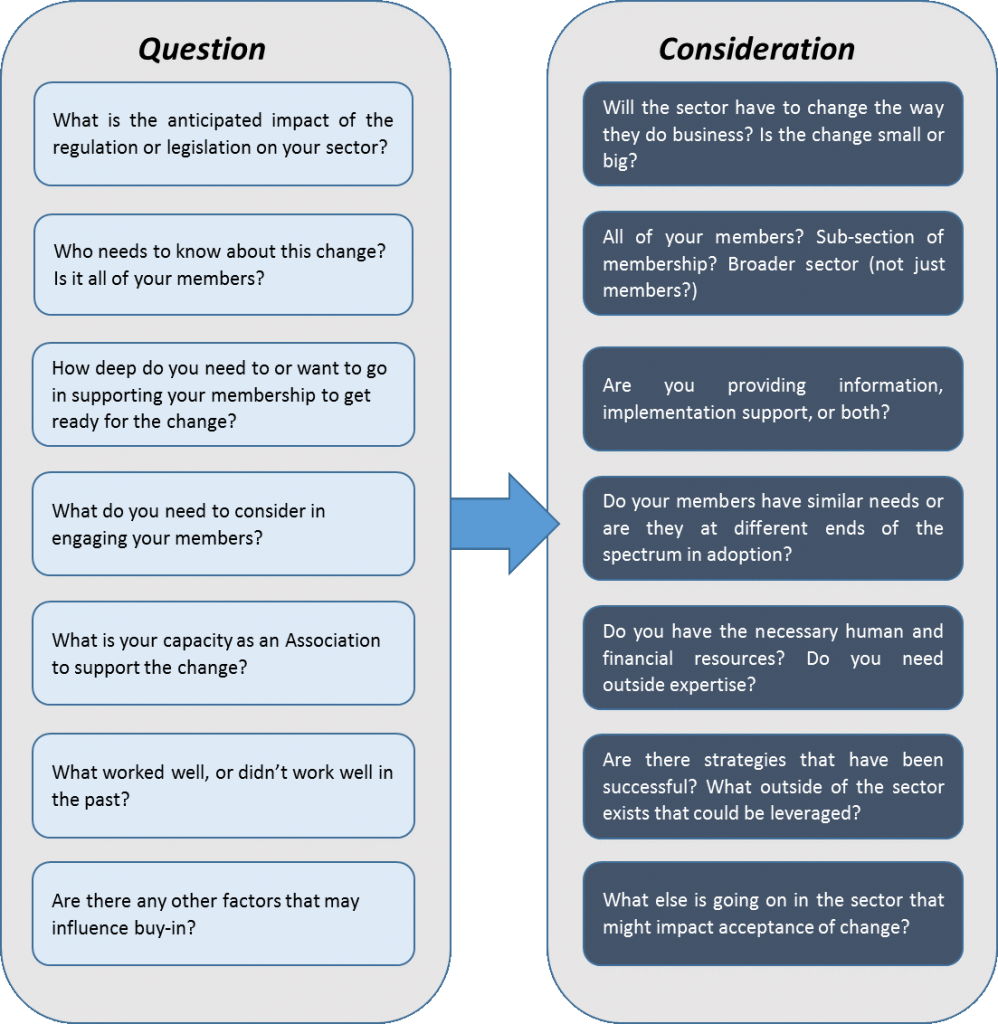Responding to Unforeseen Changes in Government Regulation
By: Terri Lohnes
In an ever changing world we are constantly faced with new regulations and legislation in an attempt to be more accountable, more transparent, and more fiscally/socially/culturally responsible. We are tasked by government with the challenge of doing things differently, until the next change comes.
As associations, you are often the messenger and conduit of this change within your sector, faced with determining how best to support your members so that they clearly understand the change and are able to respond to the change where necessary.
The reality is that when change happens there is little guidance on how to effectively action these changes. As a result, many organizations experience uncertainty and anxiety trying to understand the change, what it means to them, and what they need to do to be responsive and in compliance. For some organizations, the change can feel overwhelming; in light of all of the other work that needs to be done, the change can become lost on the priority scale.
So how do you create a sense of urgency, of understanding, and of ownership for these regulatory and legislative changes given these circumstances? How do you support your members to become familiar with new regulations and legislations and to imbed it into their operations where necessary?
For an association, this can seem like a daunting task – particularly when there is anticipated opposition to the change – but it doesn’t have to be. With a thoughtful and well laid out plan you can position yourself as a champion, and as an important ally to your existing members, as well as your broader sector. This can be your opportunity to provide added value and to be a leader within your sector.
Before determining an approach and tackling the change, associations must consider what tools will be most effective in building momentum and movement. To support adoption to change, associations should understand what their members know (or do not know) about new legislation and their requirements, as well as what they need in order to implement them. Key questions and considerations for you as an association are:
Answering these questions will allow you to design an approach to change that is realistic, achievable, and sustainable.
Once you have determined your role in communicating and/or supporting the change the next step in the process is to utilize this knowledge to develop an action plan. While the specifics of each plan are different, a strong plan often encompasses the following elements:
- Outline what your goals and objectives for your action plan are and clearly identify what it is that you ultimately want to accomplish.
- Your goals and objectives may evolve as you continue to develop your plan, but it is important to have a clear starting point.
- Consult with key government contacts or others who are very knowledgeable about the legislative or regulatory change.
- Ensure that you have a solid understanding of what the change entails and what the expectations are.
- Obtain input into what should be communicated and when.
- Consult with key stakeholders. Do not assume that your understanding of the change is the same as everyone else’s.
- It is important to talk with your stakeholders to get a sense of what they understand about the change and what their concerns may be.
- Engaging your members can help increase buy-in of your plan.
- Determine the key activities of your plan – what you need to do to achieve your goals and objectives.
- Determine the modalities that you will use to support your membership and/or sector in adopting the new regulation or legislation (i.e., web-based education sessions, in-person seminars, written materials).
- Identify benchmarks and indicators that will enable you to track implementation of the change and the effectiveness of your approach.
- Set timelines and identify key resources to accomplish each task.
- Design the materials you are using to support adoption, ensuring that they are adapted to the particular modality of implementation.
- Consider pilot testing the materials to make sure that they are supporting the achievement of your goals. Get feedback from stakeholders – ask them whether the materials make sense, and if they are in alignment with what you are trying to accomplish.
- Design and implement a communication strategy.
- Communication should start early, and occur often.
- Communication should not stop immediately after implementation of your approach.
- The strategy should identify who you are communicating with, when you are communicating, how you are communicating and the key messages that you are communicating.
- Your communication approach may be different for different audiences (members, broader sector, Board, funders).
- Take stock after implementation.
- Consider the lessons learned – what worked well, what did not work as well, and what you might do differently in the future.
Keep in mind that every organization may need a different approach, and that the same change may require different tactics, even within the same association. Regardless of these differences, it can be helpful to talk to your colleagues in other sectors to share ideas, tools, and to look for opportunities to work together. By following these steps you are setting up your Association and your membership for success. The new knowledge that you will gain of your sector through this process can also position you as an expert and advisor to other sectors, Ministries and partners.
 Spotlight: A Sample Approach for Supporting Legislative/Regulatory Change
Spotlight: A Sample Approach for Supporting Legislative/Regulatory Change
- Conduct a baseline survey. This will give you a better understanding of sector readiness to change, will validate what you think you know about where your sector is at with regard to the change, and will help to identify target audiences for your communication and/or support. This will help inform whether members are consistent in awareness and readiness, or whether they are on different ends of the spectrum. It is often the case that a multi-pronged approach is needed in order to engage members who are beginning to adopt change, to mobilize those in the middle of adoption, and to leverage those who have already implemented the change.
- Develop multiple mechanisms for communicating and/or supporting change. This may include:
- A one-day workshop or education session to build member awareness, engagement and excitement.
- Creating a learning collaborative. A learning collaborative allows you to be both narrow and deep, and to provide comprehensive support for implementation, while continually motivating members. Networking through coaches and peers helps build capability and capacity to carry out change.
- Providing online tools, templates and webinars. This promotes and supports self-directed learning.
- Conduct an outcome survey. This will help you to understand how your efforts impacted change.
Terri is the Practice Lead at OPTIMUS | SBR, with 20 years of experience in strategy design and execution, public policy development and analysis, research and innovation, communications and advocacy. She has worked extensively in the public, private and not for profit sectors, leveraging best practices and knowledge from across Canada and around the globe. Connect with her at [email protected] or via LinkedIn: (https://ca.linkedin.com/in/terri-lohnes-2358bb5 )


